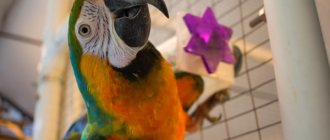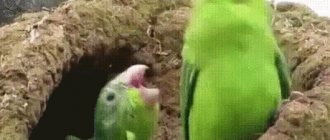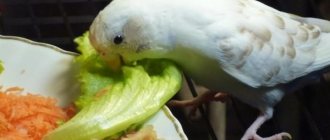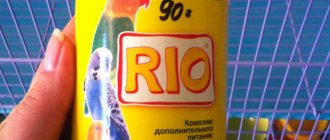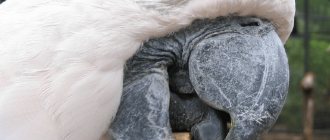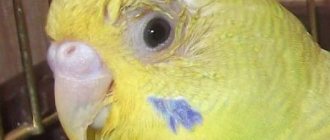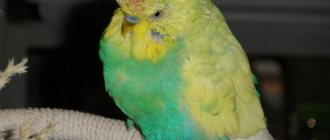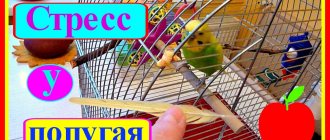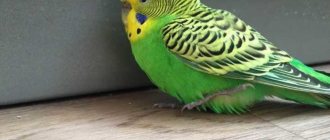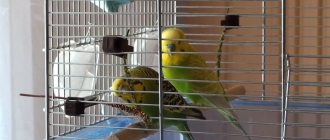- home
- Parrot
- Treatment
04/20/2019 If a parrot breathes heavily, opens its beak, becomes passive and shakes with chills - all this signals problems with the pet’s health or improper conditions of its maintenance. The listed symptoms cannot be ignored - the bird’s condition will only worsen. In order to prevent serious complications and death of the parrot, it is important to determine the cause of his difficulty breathing as soon as possible and help him return to normal life.
Possible diseases
If a parrot breathes with its beak open and a whistle is heard when breathing, this may indicate that the bird has diseases, mainly of a cold nature.
Parrots are sensitive to living conditions. Unsuitable temperature conditions and humidity levels, the presence of drafts and swimming in cool water - all of this, both in combination and individually, can lead to a deterioration in the pet’s well-being and the occurrence of diseases. The bird's respiratory organs are most vulnerable in these situations.
Optimal air parameters for the room where the parrot is kept:
- temperature +22 °C;
- humidity 60%.
While the room is being ventilated, the pet should be placed in another room. As for bathing, in the cold season the water temperature in the birdbath should be +40 °C, and in the hot summer season +25 °C is sufficient.
It is important to note that if you notice any symptoms of disease, you should contact your veterinarian. Only he can make an accurate diagnosis and prescribe treatment. Attempts to treat your pet on your own can lead to its death. The necessary therapy is selected by the veterinarian for each bird individually.
What to do if your parrot is breathing heavily with its beak open and squeaking
When a parrot is breathing heavily, the only thing the owner can do is contact a veterinary clinic. This is due to the fact that a visual examination and laboratory tests are needed - mucus and blood tests, as well as x-rays, endoscopy, etc. As part of the course of treatment, antibiotics, inhalations, and antifungal agents may be prescribed. Their dosage is determined individually for each case.
In case of stress, the owner can alleviate the condition, but this diagnosis must also be made by a doctor. In this state, you need to speak to the parrot in a calm voice - this has a relaxing effect. It is important that the bird’s cage is not crowded, and that food and water are always available. When there are also other animals in the house, you need to exclude their contact with the parrot if it is afraid and nervous in their presence.
Respiratory colds
If your cockatiel or budgerigar is breathing heavily, it is important to pay attention to whether the breathing is accompanied by any extraneous sounds. This will help identify the diseased internal organ. If bugged:
- whistling – the air sacs are affected by the disease;
- wheezing or noise – the bronchi and trachea are inflamed.
Heavy breathing through an open beak and extraneous sounds from the chest are far from the only cold symptoms in a bird. A parrot's cold can be recognized by the bluish tint of its paws. In addition, a feathered pet with a cold:
- coughs;
- moves its tail while inhaling;
- keeps the wings at a distance from the body, reducing the load on the chest;
- loses weight;
- loses coordination;
- becomes lethargic;
- sleeps a lot;
- doesn't react to anything.
Why is a parrot breathing heavily with its beak open: possible reasons
If the parrot is breathing heavily and making some sounds when breathing, this may indicate a cold-type disease. But there are other reasons that can provoke such a condition. Parrots are extremely sensitive to the conditions in which they are kept. For birds, humidity (about 60%) and room temperature are important, which should be at 22˚C. When there are deviations from this norm, the pet may get sick. Also, if there was a swim in cool water (in winter the temperature is below 40 ˚C, in summer - 25 ˚C) or the room is drafty, the pet’s condition can deteriorate extremely quickly. The cause may be impurities in the air. Poisoning can be caused by:
- aerosols;
- air fresheners;
- perfumery;
- paint and varnish products;
- tobacco smoke;
- strongly scented items, compounds, etc.
Attention!
At the first symptoms of the disease, you need to take the bird to the veterinarian, since it is impossible to independently diagnose and determine how to treat the parrot without additional tests.
Rhinitis
The disease is characterized by inflammation of the mucous membranes of the nasal passages. Rhinitis can be either an independent form or a complication in the case of advanced respiratory diseases. Parrots are characterized by the following manifestations during this disease:
- regular sneezing;
- indigestion (diarrhea);
- heavy breathing with whistling;
- swelling in the nose area;
- sinus congestion and runny nose;
- general depression of the state.
In addition to the symptoms listed, the parrot may exhibit atypical behavior. The bird will begin to rub its beak against the perch or bars of the cage, trying to get rid of congestion. The pet will also open its beak to breathe. Identification of symptoms characteristic of rhinitis is a reason to visit a veterinarian as soon as possible. In cases of severe disease, surgery may be necessary.
Respiratory disease
When a pet begins to breathe heavier than usual, the owner needs to listen to whether there are any other sounds accompanying inhalations and exhalations. This helps determine how the organ was damaged. If breathing is accompanied by a whistling sound, then most likely the air sacs are affected. If there are noises and wheezing, it is assumed that the cause of the malaise is inflammation of the trachea or bronchi. Breathing through an open beak and foreign sounds from the chest are just 2 signs of a cold. An ailment of this nature can also be recognized by a fairly pronounced blueness of the skin on the paws. Also, a bird with a cold will:
- cough and/or sneeze;
- keep the wings away from the body so as not to load the chest area;
- move your tail while inhaling;
- Lose weight noticeably and quickly enough;
- give up your usual and favorite foods.
Attention!
If a parrot is sick, it will sleep a lot, react little to external stimuli, its condition will become lethargic, and its coordination will deteriorate.
Sinusitis
During such a disease, inflammation of the nasal mucosa is accompanied by purulent discharge. The pet's breathing becomes heavy and there is wheezing. The area around the nose is swollen, the bird looks weak and lethargic. The causative agent of the disease is often a viral or bacterial infection. The appearance of sinusitis in a pet is often caused by a lack of vitamin A or a wound. If the disease is advanced, its treatment involves surgery.
Inflammation of the trachea
A common cause is hypothermia. But inflammation of the trachea can also begin due to poisoning of the parrot with toxic fumes that irritate the nasal mucosa - any chemicals, perfumes, aerosols, etc. The cause may also be a foreign body stuck in the bird’s throat. Parasitic lesions also often provoke the onset of inflammation of the trachea. There are no special signs of the disease - the parrot is just breathing heavily and whistling. Inflammation of the trachea can only be determined by a veterinarian after examining the pet.
Laryngotracheitis, bronchopneumonia
Laryngotracheitis, bronchopneumonia, pharyngitis and aerocystitis have similar symptoms. The bird's breathing is rapid and accompanied by extraneous sounds. The parrot begins to swallow air through its beak, opening it. Because of this, a whitish coating appears on the tongue. The pet twitches its tail when inhaling, and the coordination of the feathered movements becomes worse - the parrot often loses its balance.
Stroke
When a cerebrovascular accident occurs, partial damage to the brain is observed. Hemorrhagic stroke also occurs - bleeding in the brain. Then the bird's coordination is impaired and changes in behavior occur. Signs of a stroke:
- the parrot falls from the perch, cannot get up and lies unnaturally;
- there is a tremor of the tail and cramps of the paws;
- fingers in a curled position;
- breathing is slow and heavy;
- the bird looks ruffled;
- often closes eyes;
- There is no chirping or the voice is excessively loud.
On a note!
If a stroke occurs, your pet may sometimes sleep on its stomach.
Severe stress
The nervous system of parrots is extremely vulnerable, so it is easy to provoke a stressful state in a bird. A change in his usual way of life, even a loud scream next to him can shake his nervous system, provoking shock. A parrot with severe stress may experience shortness of breath. If the situation is not corrected, in some cases the bird may die.
Rhinitis
Rhinitis is associated with an inflammatory process affecting the nasal mucosa. This disease can have either an independent form or act as a complication in advanced stages of respiratory diseases.
Characteristic manifestations of rhinitis in a parrot:
- frequent sneezing;
- runny nose and sinus congestion;
- heavy breathing with whistling;
- swelling near the nose;
- depressed state;
- diarrhea.
The parrot begins to rub its beak (for example, on a perch), thus hoping to get rid of nasal congestion. It also opens its beak to prevent suffocation.
Detecting symptoms of rhinitis is a reason to immediately contact a veterinarian. Severe cases of the disease will require surgery.
Prevention methods
To prevent serious diseases of the bird, you need to carefully monitor that the conditions for keeping your pet are correct. To prevent deterioration in a parrot’s health, veterinarians recommend the following:
- Avoid hypothermia, avoid outdoor swimming and drafts in the room where the pet is kept.
- Cleaning the cage with aggressive chemicals is prohibited, as is smoking near your pet, or using aerosols or perfumes with a strong aroma.
- To prevent a stroke, the bird cannot be prohibited from flying, but physical activity must be adequate.
- Compliance with the diet - do not feed the bird with compounds for finches, canaries or hamsters.
- If the epizootic situation regarding ornithosis is bad, the parrot needs to be isolated from contact with other animals, and after returning home the owner needs to wash his hands and shoes. You should also not bring outerwear into a room with a bird.
A parrot's heavy breathing can be a sign not only of respiratory diseases, but also of a stroke or stress. Almost always, the cause of a bird’s illness is a violation of the conditions of its keeping. If your parrot is breathing heavily with its beak open and squeaking, while coughing, shaking, or other symptoms, you should consult a veterinarian. It is impossible to independently diagnose the cause of a pet’s deterioration in well-being in almost all cases - a number of studies and tests are required, which are possible only in a veterinary hospital.
Sinusitis
With this disease, inflammation of the nasal mucosa is accompanied by purulent discharge. The parrot has difficulty breathing, it is accompanied by wheezing, the area around the nose is swollen, the bird looks depressed and weakened.
The causative agents of the disease are often infections - both bacterial and viral. The occurrence of sinusitis in a parrot can be caused by:
- insufficient vitamin A content in the body;
- a wound received during a flight.
The advanced stage of the disease is treated through surgery.
Parrot sneezing - reasons
The first time an owner hears a budgie sneeze, it may be surprising. However, this is a normal reaction to stimuli, and it is also characteristic of birds. There are dry and wet sneezing. There are several reasons for dry sneezing:
- When the air humidity in the room is low, the mucous membrane in the parrot's nasal passages dries out. The bird reflexively tries to improve its breathing and sneezes;
- Parrots carefully monitor their plumage, constantly cleaning themselves and arranging their feathers. Fine fluff gets into the nostrils, causing the bird to sneeze. The situation is aggravated during the molting period, when massive loss of feathers and down occurs;
- An allergic reaction to food, dust, or animal hair occurs. At the same time, lacrimation is added to the sneezing.
On a note! Vitamin A deficiency affects the condition of the mucous membranes. The functioning of the respiratory system deteriorates. A parrot suffering from this pathology will sneeze constantly, and blood may also appear from the nostrils.
Causes of wet sneezing:
- cold;
- respiratory viral infections;
- bacterial infections;
- fungus;
- mite;
- foreign body.
When mucus flows from the nostrils or splashes fly out when sneezing, you can judge the beginning of the disease. Domestic parrots often sneeze due to hypothermia: in a draft, after bathing, at low room temperatures.
Attempts to speak
We'll end on a good note. Another reason for the opening of the beak in parrots may be attempts to reproduce sounds.
If you often talk to your bird and set aside at least some time to teach your parrot to speak, then sooner or later the pet will answer you.
And opening the beak can be the first stage in learning words.
Carefully monitor the health of your parrot, and he will delight you for many years.
As they say in The Little Prince, we are responsible for those we have tamed.
If you know any other reasons why a parrot opens its beak, write in the comments!
With this you will help many people who are faced with the same problem with their pets.
Aspergillosis
A disease caused by fungi. A parrot can become infected with a pathogen from expired or rotten food, as well as in unsanitary conditions if the enclosure is not cleaned. Symptoms include the following:
- The parrot breathes frequently and opens its beak;
- There is an apathetic state;
- The head is in a tilted position;
- Coordination is impaired;
- The bird constantly pecks itself.
An accurate diagnosis requires examination, including x-rays and endoscopy. In advanced forms, inhalations will be required. If the ornithologist has diagnosed any inflammatory or fungal disease, it is necessary to urgently begin treatment. As antibiotics, you can use a small dose of Ciprofloxacin, available in pharmacies for people. To do this, a small part of the tablet must be crushed and diluted with clean warm water. Pour into the bird's beak through a pipette twice a day. Therapy should last five days. A positive effect is observed with inhalation. To do this, you will need to place a container with a menthol or eucalyptus solution next to the cage. If the doctor allows, then warm-up is carried out under a lamp for 15 - 20 minutes. Excessive heat is avoided.
Following the veterinarian’s recommendations and a caring attitude will allow your pet to be cured in a short time. An active bird will delight its owner for many years to come.
Why does the wings and tail tremble?
Based on the criteria, the cause of the symptom of trembling in the body and tail and pathological symptoms are determined.
- Severe anxiety.
- Poor living conditions.
- Low sanitary standards.
- Parasitic diseases.
- Inappropriate microclimate (too hot or cold in the room).
- Bacterial, viral infections.
- Inflammatory processes.
- Lack of attention, sadness, loneliness.
- Low quality food.
- Jar of Hearts.
If a budgerigar hides its head under its wing, which can cause chills and inflammation, it is necessary to warm the bird as soon as possible. If the inflammation process is not treated, the pet will die suddenly.
Change of home
A change of environment is a tragic event for a pet. A new room, loud sounds, people around who pay frequent attention - everything frightens the baby. This is manifested by trembling in the body. In order for your pet to quickly get used to the atmosphere, you need to leave him alone in the cage for several hours. Then gradually accustom him to yourself, by talking, feeding, and affectionate words.
Change of owner
Corella may tremble not only due to cold and pathological reactions in the body. A change of owner comes as a blow to the bird. Birds have short-term memory and forget the old owner within 2 months. In order not to frighten the bird, visit it once every three hours the first day; the next day you need to visit the cage more often.
In quiet conversations, use a friendly intonation and affectionate phrases, which can have a positive effect on your pet’s mood.
Loud sounds
To quickly adapt your budgerigar, you should not turn on the equipment at medium or loud power: TV, tape recorder, speakers, telephones. A bird can die from fear, since stressful situations are accompanied by an increase in heart rate and the release of the fear hormone - adrenaline - into the blood, as a result of which the pulse increases more. The heart muscle cannot withstand heavy stress.
It is very difficult to identify symptoms of increased heart rate; in order to prevent disastrous consequences, you should not make sudden movements near the cage or talk loudly.
Corella loves peace and quiet, do not turn on the equipment at medium volume.
Children
A pet in the house is a joyful reason for children to check, touch, and stroke a feathered pet, which is extremely undesirable. Enthusiastic screams and emotions can stir up peace and cause injury to the cockatiel. Not allowing children to see a new bird can cause children to cry and even become hysterical. To please everyone and not spoil the calm, warm atmosphere in the family before the performance.
Before introducing the parrot, children must be warned that from now on they will speak in a quiet voice, play only calm games, otherwise the bird will fly away to other obedient, peaceful children. Symptoms of fear manifest themselves in the form of trembling in the body, adopting a sedentary posture. The pet does not like noisy environments. The cage should be spacious and neat.
The pet will not tremble provided that sanitary standards are constantly followed.
Poor nutrition
You should know that birds have a fast metabolism. Micronutrients must be supplied regularly. The diet should contain: ground cereals with the addition of dry cereals, fruits, vegetables, feed. The cockatiel will tremble in the cage if not fed enough.
